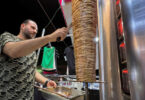ATHENS (AA): Aegean neighbors Greece and Türkiye share a number of culinary favorites apart from the famous dolma and imam bayildi, as well as sticky-sweet baklava.
One is tsoureki, or paskalya coregi (Easter buns), as they are called in Turkish.
It boasts a bread-like texture, rich in strong flavors and scents that remind many of their childhood years in Turkish Anatolia.
Its distinctive smell while being baked comes from mastic and mahleb, or mahlepi in Greek – spices commonly used in Türkiye, including for ice cream.
Mastic comes from masticohoria from the Greek island of Chios, a unique spice with a bitter taste and strong smell that gives food a different touch. Mahlepi comes from cheery seeds and is an aromatic spice that gives a distinctive smell to the dough while baking.
This strongly scented spice grows in both Türkiye and Syria.
Istanbul cuisine makes great use of rare spices like mastic and mahleb in cooking and not just breads for Easter, Aylin Oney Tan, a food writer and culinary researcher, told Anadolu.
But what exactly is tsoureki or paskalya coregi? And is it Greek or Turkish?
“We can’t give a definitive time or geography for paskalya coregi, or say whether it was first made in Greece or Türkiye, and as we all know, food culture back then was more fluid. I mean that the borders did not exist as they do today,” said Tan, referring to the countries’ shared Ottoman past.
But she explained that although the origin of paskalya coregi could be attributed to Istanbul because of the Ottoman Empire, due to the metropolis’ multicultural background, it could be a joint product of communities there.
Tsoureki is very simple and has very few ingredients, said Sofia Stavrou, who was born and raised in Istanbul, the former Ottoman capital and now major financial center.
Flour, eggs, milk and butter, including spices, can make the most delicious tsoureki, said Stavrou. She was quick to clarify that the ingredients are not what makes it delicious and fluffy – one or two simple secrets are behind a successful tsoureki.
“You should pay attention to activating the yeast by dissolving it in some warm water for a few minutes, and the other (secret) is to knead it well,” she said.
“If it’s not activated correctly then the tsoureki won’t rise enough, and then loses its texture,” she cautioned.
Origins unknown, honed by housewives
The name tsoureki “comes from the Turkish word corek, which means puffy dough that has yeast,” famed Greek chef Ilias Mamalakis told Anadolu.
Mamalakis explained how the recipe was improved by housewives who added milk and eggs. He said it is mainly baked during Christmas and Easter in Greece, thus accounting for the name “paskalya coregi,” or Easter (Pascha) corek.
“I wouldn’t say it’s a Greek product,” he said. “Tsourekia was also made in Georgia, Armenia, and Kazakhstan with small variations and almost the same name, but because Greeks liked it, it was incorporated into Greek culture with small additions and variations.”
In Greece, around Easter it is made with a round shape. But during Christmas it is made long and narrow like a braid used in exorcism, said Mamalakis. Others claim it is prepared to ward off evil.
Tsourekia was initially prepared by Greek and Armenian Christian minorities in Türkiye. From there, it passed to the locals, according to some culinary experts.
Kevser Demir Turkdogan, a food writer for kevserinmutfagi.com (Kevser’s kitchen), said: “The best versions of paskalya coregi could be found around Kurtulus Street in Istanbul, which was a once a residence for minorities. These pieces of information could point to it being a Greek recipe.”
On the other hand, the name tsoureki comes from corek in Turkish, which could mean that Turks or Turkish-speaking Greeks named it. “In that case, I assume that the recipe originally could belong to Greek people who were living in Türkiye, probably in Istanbul,” she said, referring to the city’s large Greek population, especially in centuries past.
“During Easter, paskalya coregi is more available in cities like Istanbul because of a large Christian population but not in other cities. The (southern) city of Antakya, with many active religions, might be a good source for this but unfortunately, the recent earthquakes damaged most of the city now,” Nilay Senel-Nylund, a food influencer and Turkish cuisine enthusiast, told Anadolu.
Nilay said mahlep-flavored braided coreks are widely available at most bakeries in Türkiye. It is called braided corek and is not linked to Easter. “Most of the time I see sliced almonds on top and some raisins inside,” she said.
Tsoureki is enjoyed throughout the year, said Stavrou, saying it has become a year-round treat, not just one for certain holidays.
A cup of tea and a slice of freshly baked tsoureki is something that is relished by many, she said, adding that it is commonly enjoyed by both Greeks and Turks.
“It’s one of these small cultural habits that bring us closer,” said Stavrou.







